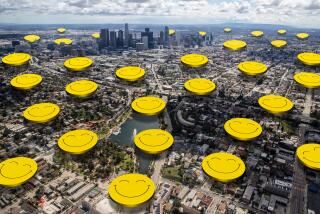Neighborly advice: Culver Crest
Culver Crest offers a genteel respite from the fast-food chains and freeway entrances along Overland Avenue. Birds sing from coral trees that hang lazily over the winding streets, and generous-size 1950s ranch homes catch ocean breezes and afford views from the Palos Verdes Peninsula to downtown L.A.
What it’s about
Sometimes described by its residents as Culver City’s “best-kept secret,” the Crest is a small, isolated hill that rises out of the southeast corner of Culver City, south of West Los Angeles College, north and west of Holy Cross Cemetery and east of Overland Avenue.
Virtually unnoticeable from the busy roads around it, the 170 homes in the Crest have become more desirable in recent years because of their expansive hilltop views and proxim- ity to the newly redeveloped downtown Culver City.
Homeowners here are a mix of original 50-year residents and young families riding the recent wave of gentrification. Because of its hilly location and lack of through roads, residents enjoy a close-knit community that is isolated from the rest of the city. El Rincon Elementary School and Blanco Park sit conveniently at the bottom of the hill.
It is a purely residential community, with no commercial zones, so although residents enjoy peace and quiet, they must venture into downtown Culver City for groceries and other amenities.
Many of the area’s ranch-style homes retain their original crisscross windows and other quaint touches, such as frontyard wishing wells and wagon wheels. Others have been made to look more traditional with red brick or Tudor-style facades.
Because of the hill’s steepness, many homes have views. It’s possible to see from the ocean to downtown Los Angeles.
Residents appreciate -- and rarely fail to mention -- Culver City’s independent-from-Los-Angeles status and small-town feel. Culver City runs its own fire and police departments and school system.
Beginnings
Lewis A. Crank and R.J. Blanco bought the hilly land and developed Culver Crest in the early 1950s as an upscale community.
Many of the 1,700- to 5,000-square-foot custom ranch homes had swimming pools and were considered large by 1950s standards.
Crank owned and developed the upper portion of the hill while Blanco developed the lower portion.
Crank built and maintained a large ranch-style home there and kept horses on his property for many years. Many streets in Culver Crest are named for Crank’s family and associates. Esterina Way is named for his first wife, Esther, and Tellefson Road was named for prominent City Council member Mike Tellefson.
Insider’s view
Cathy Zermeno, an original owner, describes the residents of Culver Crest as “one big, happy family.”
“I watch over my neighbors’ houses when they go out of town, and they do it for me,” she said.
Zermeno, who founded the Culver Crest Historical Society in 1980 and served as its president for many years, said she and her husband bought land in Beverly Hills and tried to move away but decided they couldn’t leave their cozy neighborhood. They eventually sold the Beverly Hills property.
Housing stock
Homes change hands infrequently in this desirable neighborhood, and only two are currently listed. A 3,000-square-foot home with four bedrooms, three bathrooms and a limited view is listed at $1,375,000, and a 4,300-square-foot, four-bedroom, four-bathroom home with an expansive view is listed at $2,149,000.
Report card
Children who live in Culver Crest attend schools in the Culver City Unified School District. Out of a possible 1,000 points on the 2007 Academic Performance Index Growth Report, El Rincon Elementary School scored 815. Culver City Middle School scored 770, and Culver City High School scored 751.
Sources: “Culver City: Heart of Screenland” by Julie Lugo Cerra, Culver City historian; cde.ca.gov.
More to Read
Sign up for Essential California
The most important California stories and recommendations in your inbox every morning.
You may occasionally receive promotional content from the Los Angeles Times.










